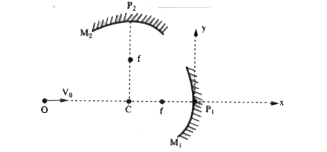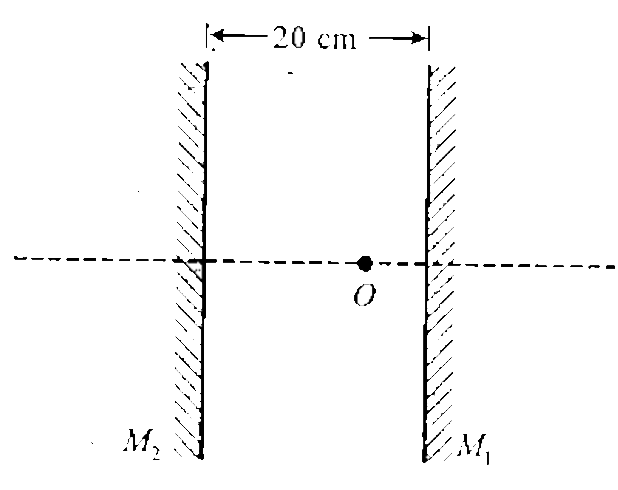Two identical concave mirrors M1 & M2 with principal axes perpendicular to each other and pole P1 of mirror M1 at origin is as shown. Let 'f' be the focal length and C be the common centre of curvature for both mirrors. A point object 'O' is at (-5f, 0) and is moving with a velocity →V=V0ˆim/s

Consider rays incident on mirror M,, the final image formed is
real
virtual
may be real or virtual
all of these
The correct Answer is:A
Topper's Solved these Questions
- GEOMETRICAL OPTICSBOOK - AAKASH SERIESCHAPTER - GEOMETRICAL OPTICSEXERCISE - PRACTICE SHEET (EXERICSE-II (LEVEL-II (ADVANCED) MATRIX MATCHING TYPE QUESTIONS))
1 Videos
- GEOMETRICAL OPTICSBOOK - AAKASH SERIESCHAPTER - GEOMETRICAL OPTICSEXERCISE - PRACTICE SHEET (EXERICSE-II (LEVEL-II (ADVANCED) INTEGER TYPE QUESTIONS))
5 Videos
- GEOMETRICAL OPTICSBOOK - AAKASH SERIESCHAPTER - GEOMETRICAL OPTICSEXERCISE - PRACTICE SHEET (EXERICSE-II (LEVEL-II (ADVANCED) STRAIGHT OBJECTIVE TYPE QUESTIONS))
2 Videos
- ELEMENTS OF VECTORSBOOK - AAKASH SERIESCHAPTER - ELEMENTS OF VECTORSEXERCISE - QUESTIONS FOR DESCRIPTIVE ANSWERS
9 Videos
- LAWS OF MOTIONBOOK - AAKASH SERIESCHAPTER - LAWS OF MOTIONEXERCISE - PRACTICE EXERCISE
98 Videos
Similar Questions
Two identical concave mirrors M1 & M2 with principal axes perpendicular to each other and pole P1 of mirro M1 at origin is as shown. Let f be the focal length and C be the common centre of curvature for both mirrors. A point object O is at (−5f,0) and is moving with a velocity →C=v0ˆi m/s.

Consider rays incident on mirror M2 the co-ordinates of the final imasge formed is
View SolutionFind the focal length of a convex mirror of radius of curvature 1 m.
View Solution
Knowledge Check
Find the focal length of a convex mirror of radius of curvature 1 m.
A1.5mB0.5mC5mD1mAn object is placed on the principal axis of a concave mirror at a distance of 1.5 f(f is the focal length). The image will be at,
A1.5fB−1.5fC3fD−3fThe distance of real object when a concave mirror produces a real image of magnification ‘m’ is (f is focal length)
A(m−1m)fB(m+1m)fC(m-1)fD(m+1)f
A concave mirror has a focal length f. An object of height 1 cm is placed perpendicular to the principal axis in front of the mirror at a distance of 2 f. Calculate the height and nature of the image formed.
View SolutionTwo plane mirrors M1 and M2 are placed parallel to each other 20 cm apart. A luminous point object 'O' is placed between them at 5 cm from M1 as shown in figure :

View SolutionA concave mirror forms an image of 20 cm high object on a screen placed 5.0 m away from the mirror. The height of the image is 50 cm. Find the focal length of the mirror and the distance between the mirror and the object.
View SolutionA concave mirror forms an image of 20 cm high object on a screen placed 5.0 m away from the mirror. The height of the image is 50 cm. Find the focal length of the mirror and the distance between the mirror and the object.
View SolutionAn object of height 0.5 m is placed in front of convex mirror. Distance of object from the mirror is equal to the focal length of the mirror. Height of the image of the object is
View Solution
